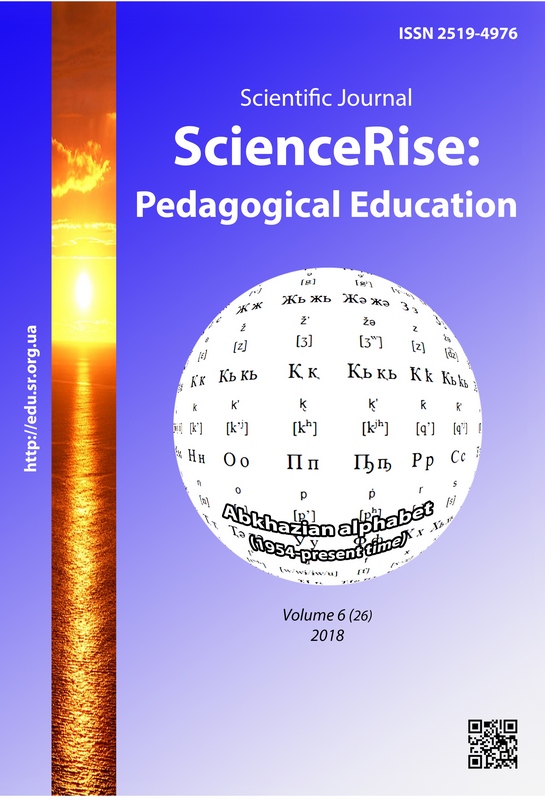A structured approach to the teaching of microbiology, virology and immunology for medical students
DOI:
https://doi.org/10.15587/2519-4984.2018.140910Keywords:
microbiology, virology, immunology, teaching, study, education, medicine, structure, technologyAbstract
One of the main requirements for medical education at present is the training of a highly skilled and competitive specialist who meets international requirements and standards. Traditional techniques that have taken place in the education system in Ukraine to date can’t fully respond to the needs of modern high-tech industries, which are in many foreign countries.
Microbiology, virology and immunology are a fundamental subject, so the information for students at the department is taught laconic and structured for more effective learning and application by students in practical classes in clinical disciplines.
The article presents the structure of the methodological provision of four main areas of conducting classes: lectures, practical, independent and individual work of students. The method used by teachers and described the use of video systems during practical classes is given. It represents the use of information in the form of tables and diagrams using video systems. This allows students to maintain visual contact with the teacher and engage them in an active conversation while discussing the topic and achieve a better effect in the end result. There are described the experience of working out of practical skills by students in classes with the use of an individual approach to each student and a scheme of preparation for acquiring practical skills that takes place in the final classes.
The use of modern tools and technologies in the training of qualified specialists in the field of medicine helps students to master the subject "Microbiology, Virology and Immunology" and acquire the necessary practical skills. It helps to develop a student's creative approach to learning, teaches analysis and systematization of information, promotes the development of professional thinking, makes it self-organized, develops analytical thinking, induces initiative, prepares for classes, makes studying interesting and dynamic, creates a level for all students’ opportunities and access to knowledge, promotes higher efficiency of material mastering
References
- Amosova, K. M., Stechenko, O. V., Vasylieva, I. V., Kovalyshyn, K. S., Zakharchenko, M. S. (2016). Naukovo-metodychne spriamuvannia orhanizatsii ta kontroliu samostiinoi roboty studentiv u NMU imeni O. O. Bohomoltsia. [Scientific and methodological direction of organization and control of students' independent work at the Bogomolets National Medical University]. Medychna osvita, 2, 60–63.
- Klymniuk, S. I., Tkachuk, N. I., Romaniuk, L. B. (2016). Suchasni aspekty vykladannia mikrobiolohii, virusolohii ta imunolohii na odnoimennii kafedri derzhavnoho vyshchoho navchalnoho zakladu «Ternopilskyi derzhavnyi medychnyi universytet imeni I. Ya. Horbachevskoho». Aktualni pytannia yakisnoi medychnoi osvity. Ternopil: Ukrmedknyha, TDMU., 179.
- Shinkaruk-Dykovytska, M. M., Poberezhna, H. M., Fedyk, T. V., Kovalchuk, L. O. (2017). Kompetentnisnyi pidkhid ta formuvannia kliuchovykh kompetentnostei v pidhotovtsi studentiv vyshchykh navchalnykh medychnykh zakladiv [Competency approach and formation of key competencies in the preparation of students of higher educational institutions]. Visnyk Vinnytskoho natsionalnoho medychnoho universytetu, 21 (1 (2)), 319–323.
- Klymniuk, S. I., Romaniuk, L. B., Tkachuk, N. I., Kuchmak, O. B., Bryhidyr, T. O. (2011). Orhanizatsiia roboty mikrobiolohichnoho hurtka na kafedri medychnoi biolohii, virusolohii ta imunolohii [Organization of microbiological group work at the Department of Medical Biology, Virology and Immunology]. Medychna osvita, 3, 92–94.
- Banks, J., McGeeBanks, C. A. (Eds.) (1995). Handbook of research on multicultural education. New York: Macmillan, 882.
- Bukhalska, S. (2009). Kompetentnisnyi pidkhid. Teoretychnyi analiz kliuchovykh definitsii vyshchoi medychnoi osvity. Nova pedagogichna dumka, 2, 84–87.
- Pro vyshchu osvitu (iz zminamy i dopovnenniamy) (2014). Zakon Ukrainy No. 1556-VII. 01.07.2014. Available at: http://sfs.gov.ua/diyalnist-/zakonodavstvo-pro-diyalnis/zakoni-ukraini/65715.html Last accessed: 21.07.2018
- Petrovska, A. O. (2017). Kompleksnyi pidkhid do vyvchennia linhvistychnykh dystsyplin. Osvitnii portal "Akademiia". Available at: https://academia.in.ua/content/kompleksny%60j-pidxid-do-vy%60vchennya-lingvisty%60chny%60x-dy%60scy%60plin Last accessed: 24.07.2018
- Shpylkivska, L. S. (2016). Kompleksnyi pidkhid do navchannia inozemnoi movy u vyshchii shkoli. Stratehii mizhkulturnoi komunikatsii v movnii osviti suchasnoho VNZ. Kyiv: KNEU, 219–222.
- Klymniuk, S. I., Romaniuk, L. B., Kravets, N. Ia., Borak, V. P. (2017). Vykorystannia suchasnykh tekhnichnykh zasobiv u vykladanni mikrobiolohii, virusolohii ta imunolohii dlia studentiv medychnoho fakultetu. Perspektyvy rozvytku medychnoi nauky i osvity. Sumy: SumDU, 52–53.
- Kravets, N. Ia., Hrot, I. M., Shevchyk, L. O. (2014). Zastosuvannia metodu modeliuvannia v protsesi navchannia mikrobiolohii. [Application of the simulation method in the process of microbiology training]. Medychna osvita, 1, 44–47.
Downloads
Published
How to Cite
Issue
Section
License
Copyright (c) 2018 Lidiya Romanyuk, Natalya Kravets

This work is licensed under a Creative Commons Attribution 4.0 International License.
Our journal abides by the Creative Commons CC BY copyright rights and permissions for open access journals.
Authors, who are published in this journal, agree to the following conditions:
1. The authors reserve the right to authorship of the work and pass the first publication right of this work to the journal under the terms of a Creative Commons CC BY, which allows others to freely distribute the published research with the obligatory reference to the authors of the original work and the first publication of the work in this journal.
2. The authors have the right to conclude separate supplement agreements that relate to non-exclusive work distribution in the form in which it has been published by the journal (for example, to upload the work to the online storage of the journal or publish it as part of a monograph), provided that the reference to the first publication of the work in this journal is included.








